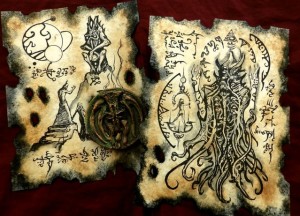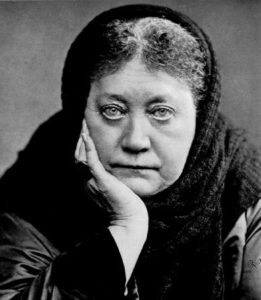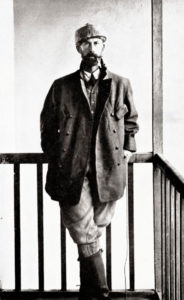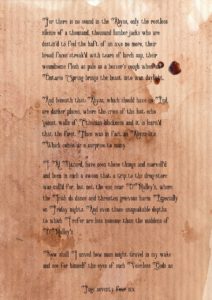We’re off on another wild multi-part adventure, involving the Victorian airship The Attila, lost cities, H P Lovecraft, Madame Blavatsky, Tibetans, E Nesbit’s ghost stories and how to be an anarchist. Did you pay any attention when we explained the true origins of the ghoul? No. Or when we told you the truth behind the Flying Dutchman? No. So we’re at it again. We are, unashamedly, greydogtales, and this is Edwardian Arcane: The Fawcett Saga.
It’s one of our fun mega-trails, so we’ll start with the easy part, and inevitably get mixed up along the way…
Forbidden Books
One of the fascinations of early weird fiction, as written by Robert W Chambers, H P Lovecraft and Clark Ashton Smith, amongst others, is the range of tantalising tomes they mention. Forbidden books, some of which drive men to terrifying and nightmarish deeds, or simply send them mad. It’s a great tradition, carried on into more recent times by writers such as Brian Lumley and Ramsey Campbell.
(We aren’t usually told what forbidden books do to women. Neurotic male scholars and artists were frequently cornered and asked why they’d spent their money on mouldering volumes of pre-human knowledge. Why hadn’t they picked up the pork chops, bread and nappies like they were told? Someone has to get real.)
Most readers of period weird fiction are familiar with the Necronomicon, the Book of Eibon and so forth. Another fun one is Robert E Howard’s Book of Skelos, from his story The Pool of the Black One (1933). This was part of the inspiration for that neat new magazine Skelos, which we covered when we interviewed Jeffrey Shanks – the secrets of skelos unveiled

Despite some having vague hopes that these were real books, H P Lovecraft himself was quite candid about the fictional nature of most of them.
“Now about the “terrible and forbidden books” — I am forced to say that most of them are purely imaginary. There never was any Abdul Alhazred or Necronomicon, for I invented these names myself. Robert Bloch devised the idea of Ludvig Prinn and his De Vermis Mysteriis, while the Book of Eibon is an invention of Clark Ashton Smith’s. Robert E. Howard is responsible for Friedrich von Junzt and his Unaussprechlichen Kulten…. As for seriously-written books on dark, occult, and supernatural themes — in all truth they don’t amount to much. That is why it’s more fun to invent mythical works like the Necronomicon and Book of Eibon.”
Letter to Willis Conover (1936)
He and his peers did reference a number of genuine publications, but you have to check to work out which were which. One such book which really existed, but which has also been dismissed by some as bunkum, is the Book of Dzyan. We’ll give you a couple of sourced mentions for this one, from the stories:
“I learned of the Book of Dzyan, whose first six chapters antedate the earth, and which was old when the lords of Venus came through space in their ships to civilise our planet. And I saw recorded in writing for the first time that name which others had spoken to me in whispers, and which I had known in a closer and more horrible way—the shunned and dreaded name of Yian-Ho.”
The Diary of Alonzo Typer, H. P. Lovecraft and William Lumley
Incidentally, Yian-Ho is the “dreadful and forbidden city” on the Plateau of Leng, from Through the Gates of the Silver Key (1934), by Lovecraft and E Hoffman Price. The Yian part may also have been nicked from Robert E Chambers, who mentions it in his story The Maker of Moons (1896). From Lovecraft again:
“But there were others he had known merely by reputation or not at all—the Pnakotic Manuscripts, the Book of Dzyan, and a crumbling volume in wholly unidentifiable characters yet with certain symbols and diagrams shudderingly recognisable to the occult student. Clearly, the lingering local rumours had not lied. This place had once been the seat of an evil older than mankind and wider than the known universe.”
The Haunter of the Dark
Dzyan Revealed
So what is this Book of Dzyan? For some time it was dismissed as a construct of Helena Blavatsky’s fertile imagination. Blavatsky (1831-1891) was an occultist and the co-founder of the Theosophical movement. Passages supposedly from this book formed the basis of her central work on theosophy in the Victorian era, The Secret Doctrine (first published in 1888).

According to Blavatsky it was based on rare Tibetan texts whose originals were secreted somewhere in Tibet or Western China. In fact, Dzyan was meant to be part of ‘secret’ commentaries pertaining to or part of the Books of Kiu-Te, which no-one at the time could identify.
For Lovecraftians, and indeed enthusiasts of many Weird Tales writers, the Secret Doctrine includes wonderful stuff. The second half of the book describes the origins of humanity through an account of “root races” said to date back millions of years. The first root race was, according to her, “ethereal”; the second root had more physical bodies and lived in Hyperborea. The third root race, the first to be truly human, is said to have existed on the lost continent of Lemuria and the fourth root race is said to have developed in Atlantis.
Side note: This is also relevant to xenoarchaeologists, who in general have little to do. Searching the ruins and remnants of ancient civilisations, including their texts, to prove that non-humans have influenced our development, is always fun. We rather like the pithy Wikipedia comment:
“Xenoarchaeology is not currently practiced by mainstream archaeologists due to the current lack of any material for the discipline to study.”
Many folk tried to demonstrate that Blavatsky made it all up, or drew on other Eastern texts to create a sort of mish-mash. The position was not helped later by the fact that Eric von Daniken was a great believer in its authenticity. In his book Gods from Outer Space (1970), he says he believes that the Book of Dzyan is more ancient than the planet, and that it points to aliens visiting the Earth. But then everything pointed to that where he was concerned.
You Say Kiu-Te, I Say rgyud-sde
But the Book of Dzyan is not yet dead and enscoffed. David Reigle, an American Sanskrit scholar, has published research on the sourcebooks accepted in Theosophy, including the Books of Kiu-te and the Book of Dzyan:
“The Secret Doctrine, H. P. Blavatsky’s 1888 magnum opus, is based on stanzas allegedly translated from a secret “Book of Dzyan.” In 125 years, not a single one of these stanzas has been traced in any known book. While we would not expect to trace verses from a secret book in known books, this has nonetheless been taken to confirm the widely held view that the Book of Dzyan is a product of Blavatsky’s imagination…. (however) I have come across significant circumstantial evidence in favor of the authenticity of the Book of Dzyan.”
Reigle, unpublished article (2013)
Reigle identifies the Books of Kiu-te as the rgyud-sde, Tibetan Buddhist tantras (which differ from the Hindu ones). Quite how Blavatsky had access to readable copies of these, no-one is sure, as a lot of the known translations of such tantras only occurred long after her death. A slightly later theosophist, Alice Bailey (1880-1949) sidestepped this sourcing problem by claiming that she herself received her material telepathically from a Tibetan master.
(We have decidedly no views on whether or not Lovecraft drew on theosophical writings as background material for his stories and general Yog-Sothothery. Clever people can argue that one.)
Edward the Theosophist
What has this to do with the price of fish? Well, you see, one of the people who helped create and collate the basis of the Theosophical Movement was a certain Edward Douglas Fawcett (1866-1960).

He knew Blavatsky, and helped Bertram and Archibald Keightley prepare The Secret Doctrine for publication. His theosophical involvement continued for many years. When his book Divine Imagining was published in 1921, it was dedicated
“To his old friend Bertram Keightley, MA, First among British thinkers to accept the imaginal hypothesis, this essay, written at his prompting and profiting by his timely suggestions, is dedicated affectionately by the writer.”
Fawcett was a lively fellow, a bit of an adventurer and a writer of some energy, producing what some call a description of a tank before such a thing existed, an Atlantean/Hollow Earth novel and many articles. He also wrote Hartmann the Anarchist, published in 1893, wherein the eponymous Hartmann terrorises London in his mighty airship The Attila. We’ll be back to that in more detail in a later part, but first we want to introduce you to his younger brother Percy.
Lost Cities
One of the other great themes in weird fiction is that of lost cities, which may include:
- terrifying but dead reminders of pre-human civilisations – snake-people, fish-people, badger-people or whatever;
- relics of earlier well-developed human civilisations whose location has simply been lost in intervening years;
- relics of more ‘marvellous’ human civilisations, such as Atlantis;
- cities which were entirely alien, constructed long ago by colonists, star-refugees, marooned wayfarers etc;
- ruins which are technically unpopulated but still inhabited or haunted by some malign supernatural or ethereal presences, and
- lost cities of white folk who did something marvellous in someone else’s back yard, like Africa or South America, and were duly feared, hated or revered by the natives

One Lovecraft-related example of the later is Great Zimbabwe, which people liked to imagine was a long-lost Phoenician, Roman, Arab or Greek colony. Actually, it was built by the locals, who were rather black, but Lovecraft liked his fantasies, as did many of his time:
“…where for thousands of years only the wandering blacks grimaced & danced, there was once a mighty city of miners & traders–perhaps an outpost of the Babylonian or Assyrian empire, a colony of Meroë or Æthiopia, a dominion of the lordly Minoans or forgotten Hittites, or that distant & mysterious land of Ophir whence the galleys of King Solomon brought gold, apes, peacocks, spices, ivory, ebony, & almug trees. Its patched & uncertain walls tell a strange story of decay—repairs shewing less & less skill as the white man faded & mixed with the black tribes of the interland.
“For some reason commerce with the outside & northern world (for the city is in Rhodesia, far down the Red Sea coast) must have been cut off—perhaps the mines gave out, so far as ancient methods could reach, tho’ modern machinery is re-opening & working them now. At any rate, the city at last fell into disrepair & decay, till crude heaps of stone & obeah-altars tell of the white man’s passing & the black’s long reign.”
Letter to Lillian Clark (1925)
The straightforward answer is that it was built in medieval times, probably by the native Shona people. The identification that it was not a fabled Phoenician outpost was pretty much established by a 1906 dig there. You can’t entirely blame HPL – even some kosher archaeologists were clinging to a Semitic or whitish origin back then.
When we were young, these ideas were dead exciting – was there really a lost Roman colony still living in the jungle and wearing suitably short togas? But age brought a more realistic curiosity – let’s just have some decent facts about who these people were, historically, and how they lived. Real life is pretty weird in its own right.
E D Fawcett’s brother Percy was a real-life, renowned Edwardian seeker of unknown peoples and lost cities (an attachment which probably led to his death). And his tale is odd enough without embellishment.
A Preview of Percival
Percival Harrison Fawcett (1867-1925?), born the year after Edward the Theosophist, was a classic man of many parts and a great adventurer/explorer.

Not unlike our favourite Hesketh-Hesketh Prichard, author of the Flaxman Low stories (with his mother), who also ventured far and wide. Interestingly, both Percy Fawcett and ‘Hex’ explored parts of South America, and both knew Arthur Conan Doyle. Both have been suggested as role-models for Lord John Roxton of Doyle’s novel The Lost World (1912) – as has a chap called Roger Casement, so we have no idea of the truth of it.
Percy Fawcett sought a lost city, and a specific one. He believed that deep in the Matto Grosso region of Brazil lay what he called The Lost City of Z. In Part Two, we will cover the Lost City of Z, more about the Fawcetts and lots of other things which bear a relationship, however dubious, to our subject. You should have us on your pub quiz team, really you should.
And as we were on the subject of terrible tomes earlier, we might as well end by sharing with you a page of that most dreadful of works, The Book of the Deaf.
This reviled volume was first published at the back of a Quebec launderette by an illiterate printer, based on the ravings of the mad Canadian Alvin “Al” Hazard. Al Hazard moved to Quebec in 1947, convinced he could speak French. It is said that his eviscerated body was found not long after The Book of the Deaf was completed. Or that he moved to Alberta…
Do join us for our second of The Fawcett Saga. It’s slightly less complicated than Part One, and it even mentions TV programmes…



